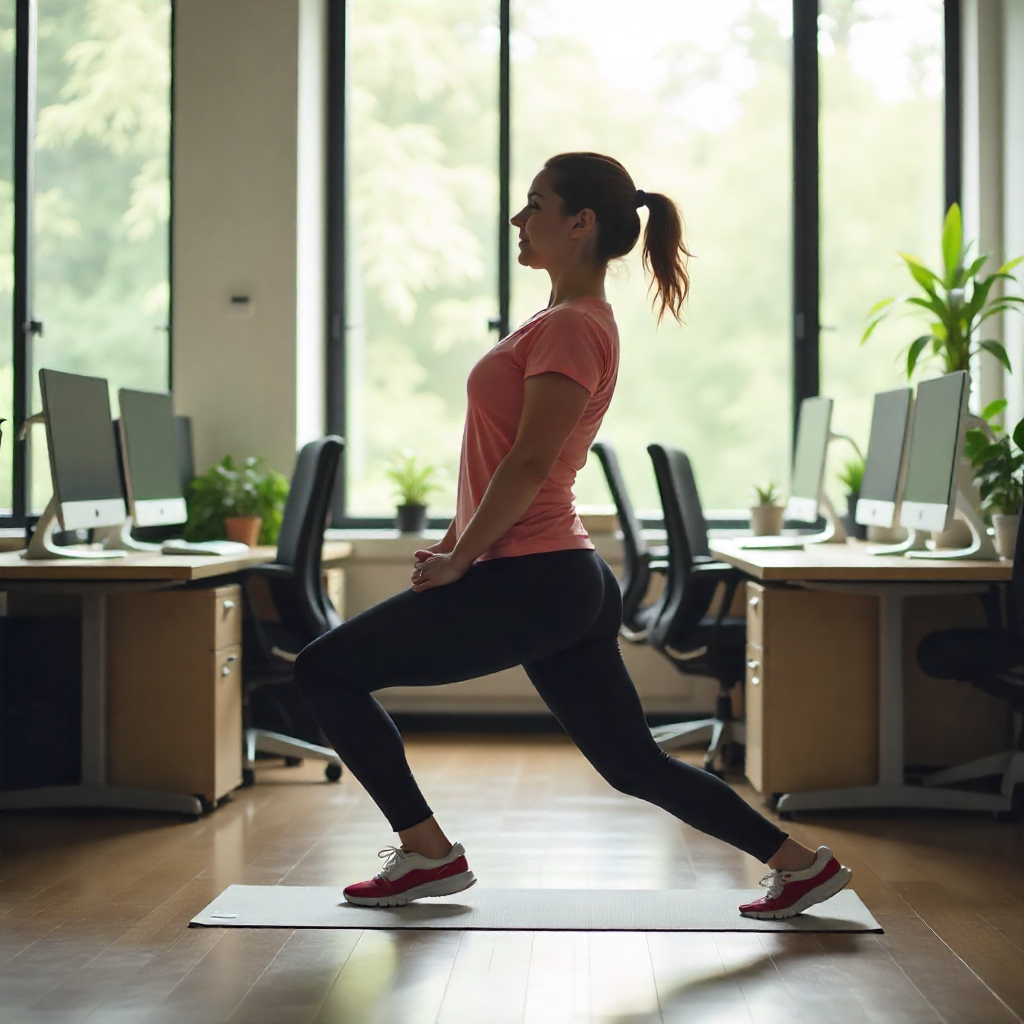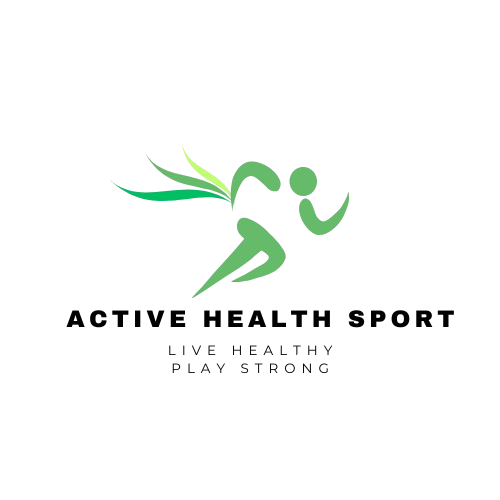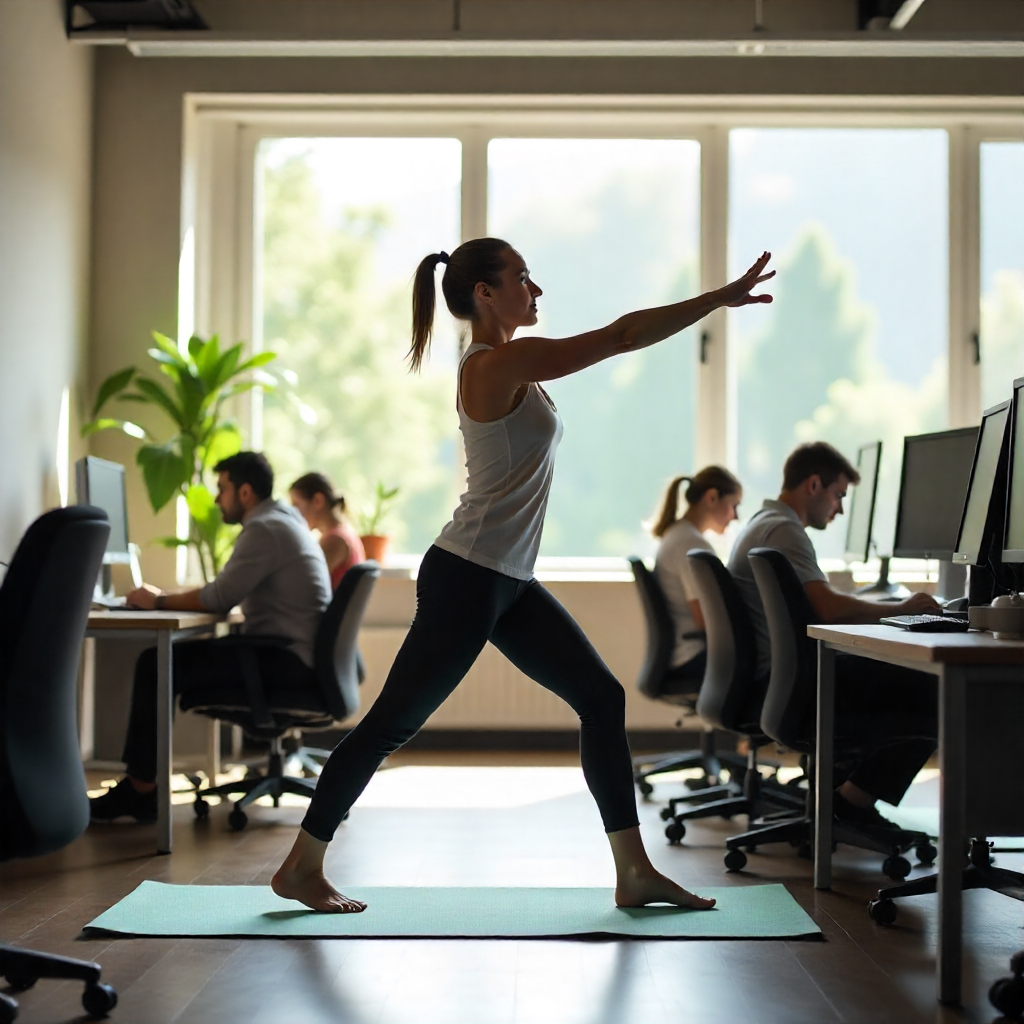Introduction: The Cost of Stillness in Modern Life
The modern human body faces a paradox. We have evolved to move, yet we’ve built a world that rewards stillness.
Whether in offices, classrooms, or home workstations, people are sitting an average of 10-12 hours per day (World Health Report, 2024). The result? Tight hips, weak glutes, compressed spines, and sluggish blood flow.
The World Health Organization now classifies “sedentary behavior” as the fourth leading risk factor for global mortality, right behind smoking, poor diet, and alcohol use.
But there’s good news: reversing this doesn’t require an expensive gym membership or a dramatic lifestyle overhaul. Science shows that intentional, small movement breaks, just 2-5 minutes every 30-60 minutes, can counteract most of the damage caused by sitting.
In this blog, we’ll unpack the latest research, real-world applications, and proven routines for restoring mobility, energy, and focus, one small movement at a time.
What Is Sedentary Damage?
Sedentary damage refers to the physiological, structural, and metabolic harm caused by prolonged inactivity. When you sit for hours, your muscles switch off, blood flow slows, and cellular processes begin to degrade.
Common Symptoms of Sedentary Damage:
- Neck and lower back pain
- Tight hip flexors and weak glutes
- Poor posture and forward head position
- Reduced energy and cognitive focus
- Increased inflammation and insulin resistance
In other words, sitting too long changes your body’s internal chemistry, from how your muscles activate to how your brain manages energy.
Also Read the Latest: Why Your Fitness Plateau Is More About Movement Quality
The Science Behind “Micro-Movement” Breaks
Movement breaks aren’t about “exercise.” They are about reactivating biological systems that shut down when we sit too long.
When you stand up and move, even briefly:
- Muscle enzymes (like lipoprotein lipase) reactivate within minutes, helping regulate blood sugar and fat metabolism.
- Circulation increases, delivering oxygen and nutrients to tissues.
- Lymphatic flow resumes, removing toxins and cellular waste.
- Core and glute muscles engage, realigning your posture and reducing spinal pressure.
A 2024 University of Toronto study found that taking a 2-minute walking break every 30 minutes improved glucose regulation by 34% and reduced fatigue scores by 47% across 8 weeks.
Another Harvard Health review (2025) concluded:
“Frequent light activity breaks, even under 5 minutes, are more effective for long-term cardiovascular and musculoskeletal health than one long workout at the end of the day.”
How Sitting Damages the Body (and Mind)
| Body System | What Happens When You Sit Too Long | How Movement Breaks Help |
| Musculoskeletal | Tight hips, weak glutes, spinal compression | Restores alignment, relieves tension |
| Circulatory | Reduced blood flow, leg swelling | Stimulates blood and lymph circulation |
| Neurological | Lower brain oxygen, fatigue | Boosts neurotransmitters, improves alertness |
| Metabolic | Slower fat metabolism, insulin resistance | Reactivates metabolic enzymes |
| Postural | Rounded shoulders, neck strain | Resets muscle balance and coordination |
Also Read the Latest: How Busy Parents Stay Strong with Functional Fitness
The 2025 Sedentary Study Revolution
Over the past three years, researchers have shifted from studying workouts to studying micro-activity, short bursts of natural movement.
- Stanford Movement Lab (2023):
People who performed 3 minutes of movement every 45 minutes had 2x fewer musculoskeletal complaints and reported 22% higher productivity. - European Journal of Physiology (2024):
A 6-week trial found that movement breaks totaling just 30 minutes daily improved spinal mobility and reduced back pain by 61%. - National Health & Fitness Institute (2025):
Introducing structured sedentary breaks at workplaces led to measurable reductions in absenteeism (by 18%) and energy crashes (by 32%).
The takeaway? Your body doesn’t need hours of exercise, it needs frequency of movement.
Real-Life Case Studies: Small Moves, Big Results
Case Study 1: “The Developer Who Stopped Hurting”
Profile: Ali Khan, a 34-year-old software engineer from Austin, Texas, working remotely for a fintech startup.
Problem: Ali spent up to 10 hours a day coding, often forgetting to stretch or move. Despite regular gym sessions four times a week, he developed persistent shoulder tightness and wrist pain, making daily tasks uncomfortable.
Intervention: After consulting Harvard Health’s guide on posture and pain prevention, Ali adopted 3-minute micro-movement breaks every 45 minutes. These included wall push-ups, shoulder rolls, and desk squats. He also began standing for a few calls each day to reduce static sitting time.
Result (after 6 weeks):
- Shoulder pain reduced by 75%
- Wrist discomfort completely disappeared
- Improved focus and lighter mood during work hours
Ali shares, “I realized my problem wasn’t a lack of exercise, it was too much sitting. Adding small movements throughout the day changed everything.”
Also Read the Latest: How Desk Workouts Keep You Active at a Sedentary Job
Case Study 2: “The Teacher Who Beat Afternoon Fatigue”
Profile: Maria Lopez, a 42-year-old high school teacher from San Diego.
Problem: Despite an active morning, Maria experienced energy crashes after lunch, accompanied by chronic lower back stiffness from prolonged standing and grading papers.
Intervention: Inspired by Mayo Clinic’s movement recommendations for sedentary jobs, Maria introduced short walking laps around her classroom and gentle standing stretches between classes. She also replaced her chair with a balance stool for part of the day to engage her core.
Result (after 5 weeks):
- Afternoon slumps vanished completely
- Notable improvement in posture and focus
- Reported higher engagement with students and reduced fatigue
“I don’t just stand taller now, I think clearer,” Maria says. “I have more energy to teach, and my students notice the difference.”

Case Study 3: “The CEO Who Reclaimed His Energy”
Profile: Daniel Reed, 47, CEO of a small tech firm in Seattle.
Problem: Daniel struggled with burnout symptoms, stiff hips, mental fog, and lack of motivation. Despite a high-end gym membership, he couldn’t maintain consistency due to his demanding schedule.
Intervention: After reading about functional movement and energy restoration in the American Council on Exercise (ACE) mobility report, Daniel began 15-minute morning mobility sessions focusing on hip openers, thoracic rotations, and deep breathing. He also added standing meetings twice a week to stay more active during work.
Result (after 8 weeks):
- Energy levels improved dramatically
- Greater mobility and mental clarity
- Better work-life balance and mood stability
Daniel shares, “I used to see fitness as something separate from work. Now, movement fuels both my focus and leadership.”
Have a Story Like This? We’d Love to Hear It!
At Active Health Sport, we believe every small movement can lead to a major transformation. Whether you’re a parent, professional, or athlete, your story could inspire others to take that first step toward better health.
📩 Share your journey with us: If you’ve overcome pain, stiffness, or fatigue through daily mobility or functional fitness, email us at contact@activehealthsport.com or reach out via our contact page.
Your success might be featured in one of our upcoming blog series!
The Anatomy of a Sedentary Break
A proper movement break isn’t random stretching, it’s purposeful reactivation of the muscles and joints most affected by sitting.
| Focus Area | Goal | Sample Movement |
| Hips & Glutes | Reactivate postural muscles | Glute squeezes, hip circles, mini squats |
| Upper Back & Shoulders | Reverse rounding, open chest | Wall slides, band pull-aparts, scapular retractions |
| Core & Spine | Restore alignment | Standing twists, pelvic tilts, spinal extensions |
| Legs & Circulation | Increase blood flow | Calf raises, marching in place, toe taps |
| Neck & Wrists | Reduce strain | Chin tucks, wrist circles, finger stretches |
Pro Tip: You don’t need a gym, just stand up, move gently, and breathe deeply.
How Often Should You Move?
| Sedentary Duration | Recommended Movement Break | Example Activities |
| Every 30 minutes | 2 minutes | Stand, stretch, walk, or perform desk squats |
| Every 60 minutes | 3–5 minutes | Mini mobility flow (hips, shoulders, core) |
| Every 90 minutes | 5–8 minutes | Short walk, stair climb, or bodyweight sequence |
The key principle isn’t intensity, it’s frequency.
Your body benefits more from 20 short breaks a day than from one intense 1-hour session.
The Famous Talk “Movement Snacks”
The concept of “movement snacks”, small bouts of activity throughout the day, has become a breakthrough in physical health research.
According to Dr. Andrew Huberman (Stanford Neurobiology Lab, 2024):
“Short, regular movement bouts create bursts of neuromuscular stimulation, helping maintain alertness, glucose regulation, and even creativity.”
Movement snacks:
- Improve mood-regulating dopamine levels
- Reignite muscle activation patterns
- Reduce mental fatigue linked to prolonged focus
Examples:
- 20 bodyweight squats before lunch
- Shoulder rolls before meetings
- 60-second march-in-place between tasks
Desk Worker’s 10-Minute Total Daily Reset
Here’s a real-world template you can apply in the office or home setup.
| Time of Day | Movement Type | Duration | Purpose |
| 9:00 AM | Standing hip opener + wall push-ups | 2 mins | Wake up joints |
| 11:00 AM | Seated spinal twist + glute squeeze | 2 mins | Restore posture |
| 1:00 PM | Walking loop + arm swings | 3 mins | Boost circulation |
| 3:00 PM | Calf raises + torso stretch | 1 min | Reignite metabolism |
| 5:00 PM | Deep squat hold + reach | 2 mins | Reset alignment |
That’s only 10 minutes total, but it’s enough to keep your body active all day.
The Mental Edge: Movement and Focus
Movement breaks don’t just reverse sitting damage; they sharpen your brain.
A 2023 University College London study showed that micro-movements every 45 minutes improved working memory, concentration, and creative thinking by up to 21%.
That’s because physical activity increases cerebral blood flow and oxygen delivery to key brain regions like the prefrontal cortex, the area responsible for decision-making and focus.
In short: move your body, sharpen your mind.
Also Read the Latest: The Most Underrated Longevity Form of Exercise in 2025
Real-World Implementation: Workplaces That Move
Forward-thinking companies are now designing environments that encourage movement:
- Google & Salesforce (2024) introduced 2-minute team stretch breaks every 60 minutes.
- Nissan’s manufacturing units installed “movement cue lights,” prompting workers to rotate joints hourly.
- Remote-first startups use wearable reminders to signal posture correction or stand-up cues.
The results?
- Fewer repetitive strain injuries
- Improved team morale
- Noticeable rise in afternoon productivity
Research Snapshot
| Year | Institution | Key Finding |
| 2023 | Mayo Clinic | Small, frequent breaks outperform single workouts for longevity |
| 2024 | Harvard Health | Small frequent breaks outperform single workouts for longevity |
| 2025 | Stanford | Movement snacks enhance alertness and prevent fatigue |
| 2024 | University of Sydney | Sedentary breaks reduced chronic pain and stiffness by 58% |
Final Insights: Movement Is Medicine
Your body doesn’t ask for hour-long workouts, it asks for regular care.
Sedentary damage isn’t caused by sitting; it’s caused by not moving while you sit.
Small, frequent movement breaks:
- Reset your posture
- Revitalize your energy
- Restore your body’s natural rhythm
Every two minutes of motion rewires your biology for health and vitality.
So, the next time your watch reminds you to stand, don’t ignore it. It’s not a nuisance; it’s your body’s way of asking to stay alive, awake, and capable.
Related FAQs
How short can a sedentary break be to make a difference?
Even 60-120 seconds of light movement, such as standing, walking, or stretching, can make a measurable difference. The key is frequency over duration, move every 30-45 minutes to improve circulation, posture, and energy.
Can standing desks replace movement breaks?
No, standing desks help posture, but can’t replace real movement. Remaining still, standing, or sitting still counts as sedentary time. Add dynamic motion like mini stretches, shoulder rolls, or a short walk to stay active.
What’s the best reminder to take breaks?
Use smart strategies like wearable reminders, phone alerts, or “habit stacking”, for example, stand up or stretch every time you check messages, finish a task, or grab a drink of water.
Do small movement breaks really burn calories?
Individually, short breaks burn few calories, but over a day, frequent micro-movements can add up to 200-300 extra calories burned, supporting better metabolism, posture, and long-term weight management.
Can regular movement breaks prevent serious back problems?
Yes. Consistent short breaks promote disc hydration, muscle flexibility, and spinal alignment, which are key to preventing stiffness, lower back pain, and postural imbalances caused by long sitting hours.
You might also like the recent posts…

Kait Amazra is the founder and lead writer of Active Health Sport. With over 25 years of experience in health, fitness, and wellness education, Kait combines professional expertise with a passion for helping people live stronger, healthier, and more balanced lives.
As a licensed health and fitness professional, Kait has worked alongside industry experts to deliver evidence-based insights on physical activity, nutrition, recovery, and holistic well-being. Through Active Health Sport, Kait’s mission is to make trusted, practical, and science-backed health information accessible to everyone, from beginners building new habits to athletes seeking peak performance.

